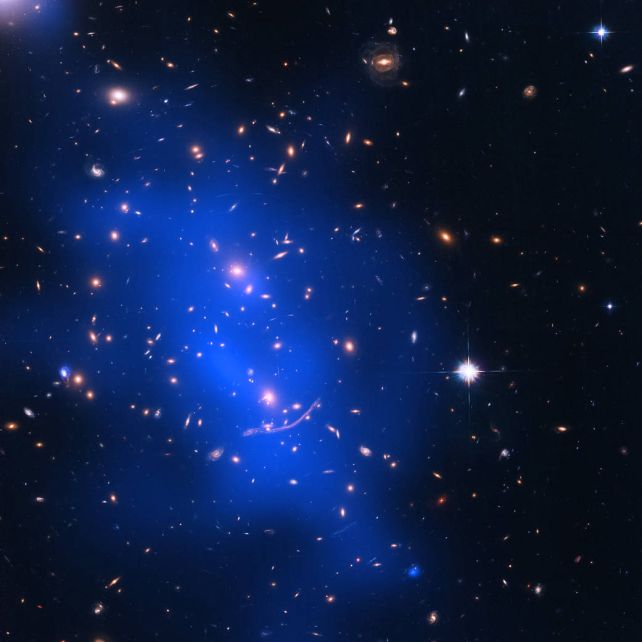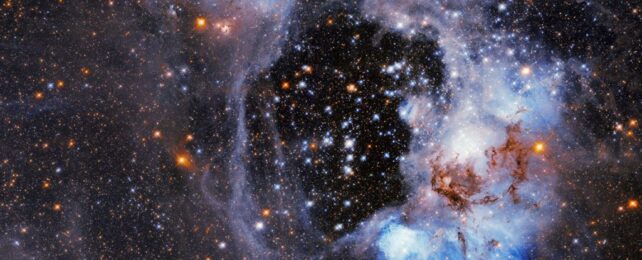A new measurement of the Universe has confirmed dark energy makes up close to 69 percent of the sum of everything.
That leaves the remaining 31 percent to matter; both of the normal variety – that's the particles and forces making up everything we can see – and dark matter, the mysterious gravitational poltergeist responsible for movements and effects that can't currently be explained any other way.
"Cosmologists believe that only about 20 percent of the total matter is made of regular or 'baryonic' matter, which includes stars, galaxies, atoms, and life," explains astronomer Mohamed Abdullah of the National Research Institute of Astronomy and Geophysics in Egypt and Chiba University in Japan.
"About 80 percent is made of dark matter, whose mysterious nature is not yet known but may consist of some as-yet-undiscovered subatomic particles."
Dark energy, on the other hand, is more of a force. We don't know what it is, either. It's the name we give for whatever it is that is driving the accelerating expansion of the Universe, and there's a lot of it out there. Repeated measurements have found that it makes up most of the matter-energy density of the Universe, in a quantity that tends to hover around 70 percent.

The expansion rate of the Universe has so far proven extremely tricky to pin down, but there are many good reasons why scientists want to do so. Narrowing down the matter-energy density of the Universe could help scientists figure out what dark energy is, how it has affected the Universe's expansion to date, and what could happen in the future: Universe expansion forever, or reversing and shrinking down to a Big Crunch.
One tried and true way to work out how much dark energy there is relies on clusters of galaxies. That's because they consist of matter that has come together under gravity over the lifespan of the Universe, around 13.8 billion years.
By comparing the number of galaxies in, and mass of, a cluster compared with numerical simulations, scientists can calculate proportions of matter and energy.
"Because present-day galaxy clusters have formed from matter that has collapsed over billions of years under its own gravity," explains astronomer Gillian Wilson of the University of California Merced, "the number of clusters observed at the present time, the so-called 'cluster abundance,' is very sensitive to cosmological conditions and, in particular, the total amount of matter."
But because most of the mass is supplied by dark matter, it's difficult to measure the mass of a galaxy cluster directly. Instead, the researchers determined the mass of galaxy clusters in their database, carefully analyzed using the team's GalWeight technique to make sure each only included cluster galaxies, by counting the number of galaxies in each one. Because more massive clusters have more galaxies, a relationship known as the mass-richness relation (MMR), the researchers were able to estimate the total mass of each of their sample clusters.
They then performed numerical simulations to generate galaxy clusters, with variable proportions of dark energy and matter. The simulations that were the closest match to observed galaxy clusters were from a Universe that consisted of 31 percent matter.
This is very close to (and an improvement on) the team's previous effort, which yielded a dark energy proportion of 68.5 percent, and matter 31.5 percent. It's also in very good agreement with other measurements of the Universe's matter-energy density, suggesting that we're very close to pinning it down.
"We have succeeded in making the first measurement of matter density using the MRR, which is in excellent agreement with that obtained by the Planck team using the cosmic microwave background method," says astronomer Tomoaki Ishiyama of Chiba University.
"This work further demonstrates that cluster abundance is a competitive technique for constraining cosmological parameters and complementary to non-cluster techniques such as CMB anisotropies, baryon acoustic oscillations, Type Ia supernovae, or gravitational lensing."
The research has been published in The Astrophysical Journal.
